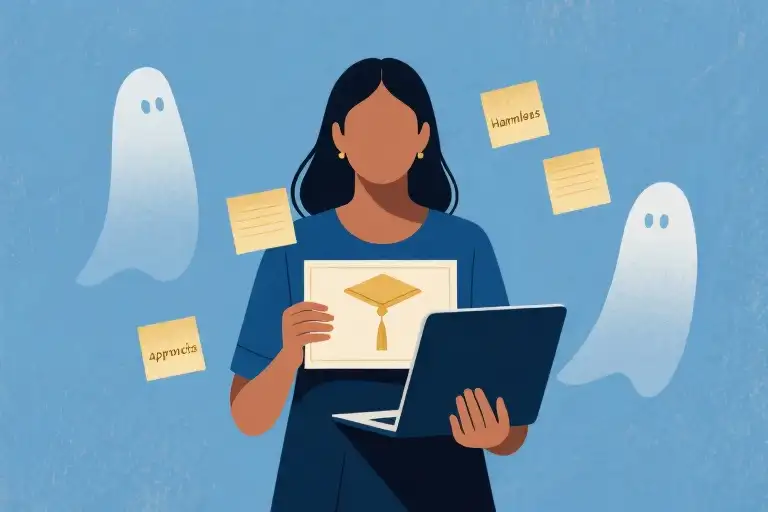The man in the coffee shop didn’t ask the bearded guy reading Nietzsche to watch his laptop. He didn’t approach the athletic-looking Black man by the window either. He chose me – a petite brown woman stirring matcha with deliberate slowness, the kind of person who looks like she’d apologize if someone bumped into her.
‘Could you watch this for a minute?’ he asked, already pushing his MacBook toward me before I nodded. That aluminum laptop with its peeling ‘Bernie 2016’ sticker became an accidental metaphor in that moment. People trust me with their valuables but rarely with their opinions. They see caretaking hands before they see the Dartmouth diplomas hanging in my apartment.
This wasn’t the first time. There was the woman in the airport bathroom who handed me her screaming infant while adjusting her headscarf. The colleague who always asks me to take meeting notes because ‘your handwriting looks so neat.’ These interactions share DNA – they’re transactions built on the assumption that I exist to serve quietly.
At first, I collected these moments like merit badges. See how safe I make people feel! Then the pattern emerged: being perceived as harmless often means being rendered invisible. That laptop guard duty came with unspoken terms – stay in this chair, don’t touch the coffee, remain exactly as nonthreatening as you appear right now.
What unsettles me isn’t the ask itself, but the automatic calculus behind it. My body gets processed through some cultural algorithm that outputs ‘safe’ before my resume, my degrees, or the protest signs in my closet enter the equation. There’s a particular flavor to this brand of trust – it’s the kind you extend to furniture.
I write this not from anger but from fascination. As someone who studied computational linguistics, I can’t help but reverse-engineer these social codes. The syntax of race and gender assembles itself differently in Delhi than in Boston, but both systems share core programming – they tell certain bodies where to sit, what to hold, and how much space they’re allowed to occupy.
That coffee shop encounter became my Rosetta Stone. When a white man chooses a brown woman to guard his possessions, he’s not seeing me – he’s seeing the absence of threat. My usefulness begins and ends at the borders of his comfort. The real question isn’t whether to say yes next time, but how to make the invisible algorithm visible.
The Weight of Being Trusted
The laptop was a sleek silver MacBook Pro, its glowing apple logo reflecting the café’s Edison bulbs. A man I’d never met hovered beside my table, shifting weight between his Cole Haan loafers. ‘Could you watch this while I use the restroom?’ he asked, already sliding the computer toward me before I nodded. My matcha latte left a faint green mustache on the cup’s rim as I said ‘Sure’ – that automatic response honed through years of similar requests.
This transaction lasted twelve seconds. The man returned eight minutes later with a curt ‘Thanks’ and no eye contact. What lingered wasn’t the interaction itself, but its unspoken premise: my petite frame and brown skin made me the ideal temporary custodian for his $2,000 device. Harmless. Non-threatening. Conveniently forgettable.
The Bathroom Stall Epiphany
Months later in a department store restroom, a white woman thrust her squirming toddler toward me over the diaper changing table. ‘Could you hold her legs?’ she panted, as if we were wartime comrades rather than strangers. The baby’s pink socks left dusty footprints on my black Theory blazer. Neither mother nor child would remember this moment; for them, I was merely a pair of helpful hands emerging from the background.
These incidents share DNA with workplace ‘compliments’: ‘You’re so easy to work with’ (translation: you don’t challenge my assumptions). ‘Your English is excellent’ (translation: for someone who looks like you). The cumulative effect isn’t offense but erasure – being appreciated for fitting predetermined molds rather than recognized as complex individuals.
The Mechanics of Harmlessness
Social psychologists call this phenomenon ‘benevolent stereotyping.’ Unlike overt racism, these microaffirmations carry the sheen of positivity while still reducing people to caricatures. My Ivy League degrees become surprising plot twists rather than expected achievements. Colleagues express shock at my ‘articulate’ presentations, their praise laced with the unspoken ‘for your type.’
What makes these interactions particularly insidious is their camouflage as courtesy. Refusing the laptop-watching request would make me seem rude; pointing out the coded language in workplace praise risks being labeled oversensitive. The burden of politeness falls disproportionately on those already bearing the weight of stereotypes.
A 2019 Harvard Business Review study found that Asian-American women face the highest pressure to exhibit ‘communal’ traits (nurturing, accommodating) in professional settings, often at the expense of leadership opportunities. Our perceived harmlessness becomes a glass ceiling in itself – we’re trusted with laptops but rarely with promotions.
The Convenience of Certain Faces
Strangers’ trust reveals less about my character than about their own comfort. In predominantly white spaces, certain bodies serve as emotional support animals for the dominant culture’s anxiety. We become living security blankets – present enough to provide reassurance, invisible enough not to disrupt the existing order.
There’s peculiar irony in being simultaneously hyper-visible as a racialized subject yet fundamentally unseen as an individual. The same features that mark me as ‘other’ in most American contexts render me nonthreatening enough to safeguard valuables. This paradox follows me from coffee shops to boardrooms, where being perceived as safe rarely translates to being valued as essential.
What begins as minor social friction accumulates into existential abrasion. Each ‘harmless’ interaction subtly files down edges of identity until we risk becoming the smooth, unremarkable surfaces others already perceive us to be.
The Ivy League Resume and the Sticky Note Identity
My Dartmouth diplomas hang in expensive frames on my office wall. Beneath them sits a bookshelf filled with academic awards, published papers, and conference name tags that once granted me access to rooms where important decisions were made. On paper, I’m the model minority success story – the kind that gets trotted out during diversity panels. But in the flesh, I’m often reduced to a single sticky note: ‘harmless.’
The Resume
- Dual master’s degrees from an Ivy League institution
- Peer-reviewed publications in three languages
- Keynote speaker at international conferences
- Named one of ’30 Under 30′ in my field
The Sticky Notes
- ‘You’re so approachable’ (department chair)
- ‘I feel safe around you’ (neighbor)
- ‘Your voice is so calming’ (podcast listener)
- ‘Can you help with this? You’re so good at these little things’ (senior colleague)
The cognitive dissonance first hit during a job interview at a prestigious Boston firm. The hiring manager – a white woman in her fifties – leaned across the table after reviewing my credentials: ‘You seem so… gentle for someone with these qualifications.’ Her tone suggested this was a compliment. My stomach suggested otherwise.
These microinteractions form what sociologists call the ‘glass floor’ – the invisible barrier that keeps certain people perpetually positioned as support staff rather than leadership material. My degrees might get me in the door, but my brown skin and petite frame often determine where I’m seated once inside.
A particularly revealing moment came during a faculty meeting at Dartmouth. As the only woman of color in the room, I’d prepared extensively to present my research. When technical difficulties arose with the projector, the department head turned to me without hesitation: ‘Sweetheart, you’re good with these gadgets, right?’ Never mind that my expertise was in postcolonial literature, not audiovisual equipment. The room chuckled approvingly at his ‘endearing’ remark.
This phenomenon isn’t limited to professional spaces. Even in academic circles that pride themselves on progressive values, I’ve noticed how my contributions get framed. When white colleagues present bold ideas, they’re ‘visionary.’ When I express similar thoughts, I’m ‘thoughtful’ or ‘nuanced’ – code words that subtly position me as commentator rather than creator.
What makes these experiences particularly disorienting is their veneer of positivity. Unlike overt racism that’s easy to name and confront, this brand of bias comes wrapped in compliments and trust. It took me years to recognize why certain praise made my skin crawl – why being called ‘the most delightful colleague’ during performance reviews felt like being handed a participation trophy at the Olympics.
The model minority myth compounds this by pressuring us to be grateful for whatever crumbs of acceptance we receive. After all, isn’t being seen as harmless better than being seen as dangerous? Isn’t being trusted with strangers’ laptops preferable to being followed in department stores? These false binaries prevent us from questioning why our full humanity remains so rarely acknowledged.
My breaking point came during a campus diversity initiative where I was invited to speak about ‘soft skills for minority scholars.’ As I sat listening to other panelists discuss code-switching and emotional labor, I realized we’d been assembled not as experts in our respective fields, but as experts in our own marginalization. The irony was almost poetic – even in spaces designed to address inequality, our primary value remained our ability to discuss being unequal.
Now when I look at my framed diplomas, I see two parallel transcripts. The official one lists my academic achievements. The unwritten one documents all the times my expertise was politely ignored while my perceived harmlessness was enthusiastically utilized. Both are real. Only one gets displayed on office walls.
Two Operating Systems, The Same Bug
The first time I understood caste was when my grandmother refused to let our maid sit on the living room sofa. I was seven. The rules were unspoken but absolute – some bodies belonged in certain spaces, others didn’t. Years later in America, when a colleague casually mentioned our office needed ‘more diversity hires,’ I recognized that same operating system, just with different error messages.
India’s caste system operates like preinstalled software – everyone knows their version number. My Brahmin surname precedes me into rooms, announcing my place in the hierarchy before I speak. But America’s racial coding runs in background processes. Here, my brown skin triggers silent subroutines that assign me attributes: non-threatening, hardworking, temporary. Both systems share the same core function – reducing human complexity to executable social scripts.
Consider the data: Asian women with graduate degrees are 21% less likely to reach executive positions than equally qualified white women (Pew Research, 2021). We’re the model minority until we’re not model enough. In India, my caste would guarantee certain privileges; in America, my Ivy League degrees should do the same. Yet when the Starbucks barista automatically hands me the ‘wrong’ coffee order – the cheaper one – I taste the same bitter truth in both countries: systems don’t see individuals, they see algorithms.
What fascinates me isn’t the differences but the shared glitches. The way upper-caste Indians and white Americans both say, ‘But I don’t even see caste/race’ while benefiting from its architecture. How my aunt complains about ‘reservation quotas’ for lower castes, then fumes when Asian admission quotas are suggested at Harvard. These aren’t contradictions – they’re features of systems designed to maintain hierarchy while pretending otherwise.
Sometimes I conduct little experiments. When white colleagues ask why I’m ‘so quiet’ in meetings (I’m not), I now respond: ‘Do you think it’s my Indian accent or my gender that makes you perceive me that way?’ The panic in their eyes reveals the system reboot – suddenly they’re forced to see the code running beneath our interaction. It’s uncomfortable. Necessary. And fundamentally the same work I should be doing back home when relatives praise my ‘modern’ marriage while judging intercaste couples.
These operating systems won’t crash overnight. But perhaps we can force some unexpected system updates – starting by noticing when we’ve been reduced to background processes in someone else’s social architecture.
The Practice of Peeling Off Labels
There’s a particular kind of exhaustion that comes from being perpetually miscast in other people’s narratives. After years of playing the “harmless brown woman” in coffee shops and conference rooms alike, I started experimenting with small acts of rebellion – not the loud, dramatic kind, but quiet disruptions to the expected script.
Strategy 1: The Disarming Question
When the now-familiar scenario plays out – a stranger at the neighboring table gestures toward their laptop with that trusting smile – I’ve learned to pause. “Why me?” I’ll ask gently, watching their face rearrange itself in real time. The question isn’t accusatory; it’s genuinely curious. Sometimes they laugh nervously, mentioning some vague notion of good energy. Other times, their eyes dart to my Dartmouth hoodie before landing back on my face, as if noticing me properly for the first time. This micro-intervention creates just enough friction to disrupt the automatic labeling process.
Strategy 2: Controlled Complexity Leaks
In professional settings where colleagues default to praising my “calm demeanor,” I’ve started strategically revealing incongruent details. Mentioning my kickboxing hobby during lunch chats, or casually referencing my graduate thesis on postcolonial labor movements when asked about my “accent.” These aren’t confrontational corrections, but breadcrumbs leading toward a more complete portrait. The key is dosage – too much at once triggers defensive reactions, while measured reveals allow adjustment time.
The Time Overcorrection Backfired
After particularly frustrating week of being mistaken for administrative staff (despite my “Dr.” title), I confronted a new colleague who’d asked me to fetch coffee. “Do I look like the help?” I snapped. His stunned apology felt hollow, and the office tension lingered for weeks. The lesson? Systemic labels can’t be shattered through individual explosions – they require sustained, strategic pressure. Now I keep a mental checklist: Is this about education or punishment? Will this interaction create space or just rubble?
What makes these micro-strategies sustainable is their dual function. They’re not just about correcting others’ perceptions, but about reminding myself that I contain multitudes no label can hold. Some days it works better than others. Some days I still automatically say “sure” when asked to watch laptops. But in the space between that reflex and my next thought – that tiny gap where agency lives – I’m learning to pause more often.
The Mirror and The Label
The last sip of matcha leaves a grassy aftertaste on my tongue as I stare at the stranger’s MacBook. Its glowing apple logo feels like an ironic wink – the universal symbol of knowledge reduced to a prop in this unspoken transaction. He’ll return from the bathroom expecting to find his untouched laptop, and he will. What he won’t find is the mental note I’ve just added to my invisible ledger: Today’s tally – one request to guard property, zero requests for my opinion on the Keynesian economics paper open on his screen.
These moments accumulate like coffee rings on the surface of my identity. The diaper-changing incident in the airport restroom. The elderly woman who handed me her purse while adjusting her orthopedic shoes. Each interaction follows the same unspoken script where my body – petite, brown, female – gets cast as communal safety deposit box. It’s trust without recognition, visibility without being seen.
What unsettles me isn’t the requests themselves, but their underlying arithmetic. The calculus that determines who gets approached to watch belongings versus who gets asked to watch ideas. At Dartmouth, my economics professors praised my thesis on behavioral finance while classmates still defaulted to asking me for notes rather than debate positions. Corporate recruiters admired my dual Ivy League degrees yet kept assigning me “team culture” tasks over analytical ones. The pattern holds across continents – in Mumbai boardrooms, I’m the acceptable face of diversity; in Boston coffee shops, the human equivalent of a coat rack.
Perhaps this is why the laptop moment lingers. Not because it’s extraordinary, but because it’s so ordinary it becomes diagnostic. Like finding sugar in your urine – a routine test revealing systemic conditions. The man needed a temporary placeholder for his valuables, and in that transaction, I became functionally interchangeable with the empty chair beside me. My degrees, my ambitions, the complex personhood contained within this brown skin – all temporarily suspended in service of someone else’s convenience.
So I leave you with this question: When you look at me, or anyone bearing society’s invisible labels, what exactly are you seeing? The person before you, or the mental shortcut your brain has helpfully provided? The next time you’re tempted to hand your laptop to the nearest non-threatening stranger, consider pausing just long enough to wonder – who might they be when they’re not playing your supporting character?
Your stories wanted:
- Share an experience of being reduced to an invisible label at [email protected]
- Further reading: Citizen by Claudia Rankine, Caste by Isabel Wilkerson
- Podcast episode: “The Weight of Invisible Labor” on Code Switch (NPR)





